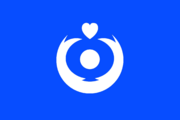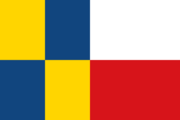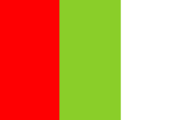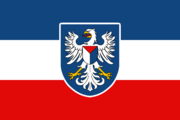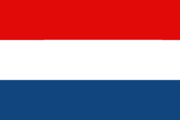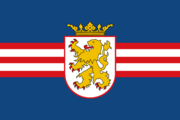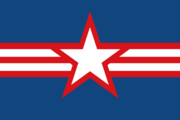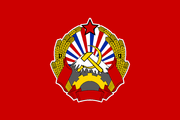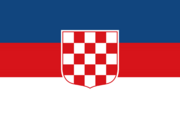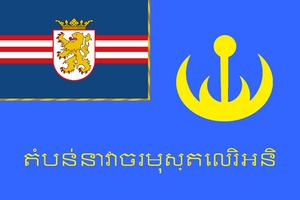Flag of Zhousheng
 | |
| Names | The Twelfth Sun (Tuƌeчetne Sλnƌe), The Unity Banner (Prapor Odnety) |
|---|---|
| Use | |
| Proportion | 2:3 |
| Adopted | May 12th, 1912 |
| Design | A argent flag with an argent twelve pointed star with a azure circle within it in a gules circle, surrounded by 16 rays, interchangably gules and azure |
| Designed by | Filip Noƿotƞin |
 Variant flag of Zhousheng | |
| Use | |
| Proportion | 2:3 |
| Adopted | April 1855 |
| Design | A argent flag with or, gules, azure and vert rays |
| Designed by | Unknown, traditionally Emperor Гejkob Чepiчkik II. |
 Variant flag of Zhousheng | |
| Use | |
| Proportion | 2:3 |
| Adopted | September 6th, 1943 |
| Design | Zhoushi flag, centered in 1/5 of the width, surrounded by or border |
| Designed by | Filip Noƿotƞin |
 Variant flag of Zhousheng | |
| Use | |
| Proportion | 2:3 |
| Adopted | September 6th, 1943 |
| Design | Zhoushi flag in Canton on a light azure field |
| Designed by | Filip Noƿotƞin |
The Flag of Zhousheng (Zhoushi: Ʒөшinƌka flaga), officially the National Flag of the Federal Republic of Zhousheng (Zhoushi: Narodƞi Flaga Federalƞi Republiky Ʒөшengu) is one of the official symbols of the Federal Republic of Zhousheng.
Design
| Scheme | ARGENT White |
AZURE Blue |
GULES Red |
VERT Green |
OR Gold |
|---|---|---|---|---|---|
| HEX | #FFFFFF | #003A80 | #C00000 | #B6E741 | #F1C000 |
| Values | Peace | Progress | Tradition | People | Riches |
| Resources | Salt | Water | Blood | Forests | Harvest |
| People | Zhengians | Bogmians | Christians | Belgorians[1] | Kammists |
Meaning
The Zhoushi national flag is the official symbol of the Federal Republic of Zhousheng and is used as such. The twelve-pointed star represents the sun, which goes right above people's heads, as Zhousheng is a equatorial country. The reason, why the star is twelve pointed is lost to history, but the most prominent theory assumes its link either to the christian 12 tribes of Israel / 12 Apostles or the old Zhoushi numbering system. The blue circle inside the star symbolizes water, the red circle around symbolizes blood, as Zhoushi liked to portray themselves like peaceful people without expansionist tendencies co-existing in one area, while the surroundings were bloody battlegrounds of clashes between people not bound by co-existence, but by bloodline and genocides. This usage also shows the star as a type of "fortress" to protect the peaceful from the vengeful.
The rays around the symbol are of unknown origin. Some ideas of explanations of what they stand for are:
- The eras of war (symbolized by gules) and peace (symbolized by azure) with the outside world outside of Mustelaria
- The number of old proto-nations surrounding ancient Zhengia (this claim has been questioned by historians)
- The rays of the Sun, bringing water (azure) and drought (gules)
- Some ancient lost symbol of ancient 10th century Kammism
History of the flag
The flag was designed in early 1910's with the creation of the Zhoushi Union. The original designer, Filip Noƿotƞin, took the coat of arms of Zhousheng City, where the original Union treaty was signed, and expanded it to the 2:3 banner and added a old traditional Zhengian symbol of the twelve-pointed sun. The flag was used mostly ceremoniously until the War of the Council came.
In 1939, with the creation of the Southern Force, a question came about what should the unified armies use as their insignia. Southern Force eventually decided to wave the flag of the Union, which was until then rarely used. With the war coming to a close, both countries realized, that cooperation and federation would make both's position more stable and favourable than the status quo.
With the fall of Orlobirg, probably the most famous picture of the Zhoushi flag was taken, with soldiers of the Unified Zhoushi Army raising the banner over the Rada, a fomer military and political headquarters of the Council State. This image was probably the main reason, why the Union flag was preserved as the future flag of the Zhoushi Federation. The protocol of the waving of the Zhoushi flag was written by Filip Noƿotƞin, the original person who designed it, with the creation of the federation in 1943.
The flag is currently protected by law as a national symbol and is one of the most notorious symbol of Zhousheng, easily recognizable all around Anteria.
The Zhoushi flag was officially raised onto the new Zhoushi Parliament on 6th September, 1943, the day of the unification of the two countries. At the same day, the second law ever created by Zhousheng (first was the Unification Bill which established the Federation) specified the design of the flag and created special war flag and naval ensign and specified rules about the display of the flag.
Allowed additions
The Zhoushi flag, according to the protocol, allow multiple modifications, which may, but are not required, to be included.
Finial
A stylised finial, which includes a stylised central symbol of the Zhoushi coat of arms and a letter "Ʒ", which stands for Ʒөшeng (name of Zhousheng in Zhoushi language)
Another acceptable fringes, according to the Vexillological association, include a golden sphere and a spear tip. Those tips, are, however, recommended for flag larger poles and used standards.
Flag pole
A Zhoushi tricolor (azure-argent-gules) wrapping is allowed around the flag pole. Vexillological association recommended the use only in special cases, as people shouldn't touch the tricolor with their arms.
Fringe
A golden fringe is allowed to be added to the flag. In the case of the war flag, the golden border is sometimes removed when the fringe is present (Vexillological association didn't condemn this practice, although they recommended keeping the golden border even if the fringe is added).
National color pennon
A vert pennon can be included above the flag on the same flag pole, with the dimensions of 1:24, where the lenght of the pennon are equal to the lenght of the flag.
Motto pennon
Another pennon can be included, this one should be argent or gules, with the dimensions 1:16. On this banner, a national motto Peꝛez doby fu buducnoшꞇ (national motto "Through the ages towards future" in Zhoushi language) should be written in capital letters in gules or gold (depending on the color of the pennon).
All additions at once
If your flag has all additions at once (the tricolor wrapping might be excluded), the flag is called Чestna flaga ("Honorary flag" in Zhoushi language). This flag is often displayed in many national celebration ceremonies, such as Victory day and Unity day (5th and 6th September).


Flag hanging protocol
The protocol specifies the hierarchy of the flags:
- International organization flag
- Federal flag (flag of Mustelaria)
- National flag (flag of Zhousheng)
- Regional flag / autonomous flag (flag of the Grad Autonomy)
- Historical regional flag (flag of Bogmia...)
- Municipal flag (flag of the City of Gasnowice...)
- Company flag (flag of NARTEL TV...)

This is the proper way of folding the flag. It is sometimes referred as the ⅓ rule, as every fold is in ⅓ of the width/height of the flag
Internal protocol
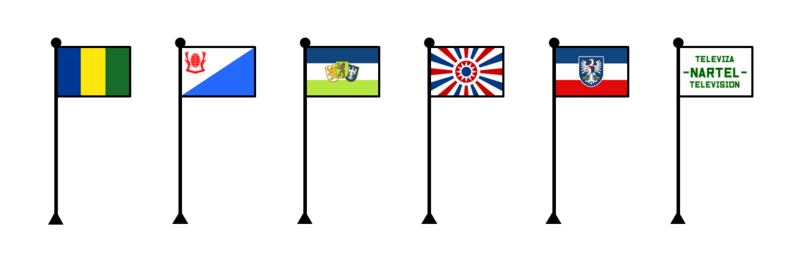
Flags should be in this order (left to right): Municipality, region, Mustelaria, Zhousheng, historical area, company
Example: Flag of Helinov, flag of the Mosterec Region, flag of Mustelaria, flag of Zhousheng, flag of Bogmia & flag of NARTEL
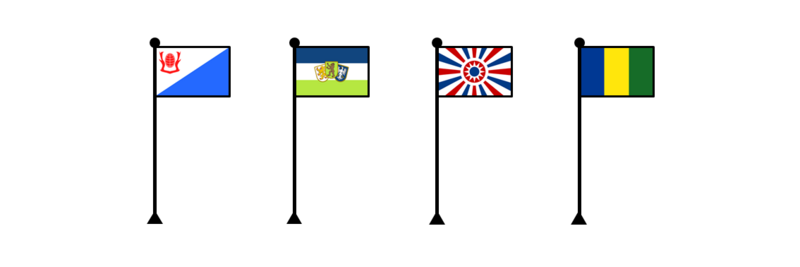
However, Mustelarian flag should be always centre/centre-left and Zhoushi flag should be right from it, so if the flags are moved to one of the sides, balance it with a lowest value flag
Example: Flag of the Mosterec Region, flag of Mustelaria, flag of Zhousheng & flag of Helinov

The only exception is Mustelaria flag triad, where the Zhoushi flag should be on the left, while Monte Blancan flag should be on the right. The Mustelarian flag can be elevated above the other flags.
Foreign visit protocol
Two-sides meetings

In the case of repeating flag alley, Zhoushi flag must be always first and/or be on the left
Example: Interchanging flag of Zhousheng and flag of Prei Meas
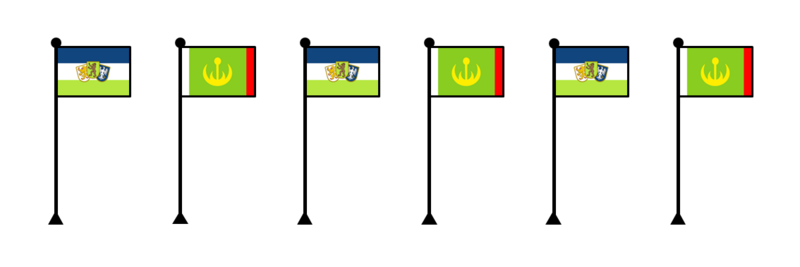
Same rules apply to the Mustelarian flag. Mustelarian and Zhoushi flags are hung to symbolize the meeting (if the visit to Mustelaria as a federation or Zhousheng as a federal republic)
Example: Interchanging flag of Mustelaria and flag of Prei Meas
Multi-national summits
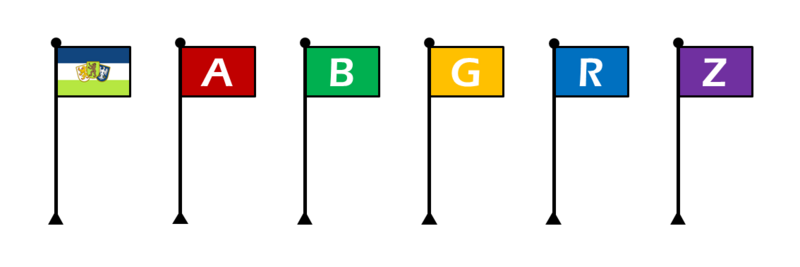
In case of a multinational summit in Mustelaria/Zhousheng, the flags should be listed in alphabetical order based upon Zhoushi terms for the countries, however, Zhoushi flag gets the honorary first place
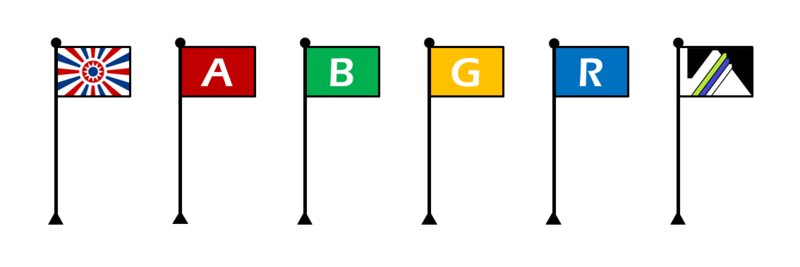
Same rules apply to the Zhoushi flag. Mustelarian and Zhoushi flags are hung to symbolize the meeting (if the visit to Mustelaria as a federation or Zhousheng as a federal republic). If the meeting is within Zhousheng and the Zhoushi variant is used, Monte Blanco is given a honorary last place, which is the second most priviliged position[2]
Prybourne dilemma
In October 2019 Zhoushi representatives met with Prybournian representatives. However, a kliché happened, as technically, Prybourne is both a conglomerate of companies and a country. Eventually, Zhoushi vexillological association recommended use of the two-sides meeting protocol, however, some vexillologists disputed the decision and rather recommended use of internal company rule, where there would be flags of both Mustelaria and Zhousheng.
With the Sekidean banner
Note: The rule could technically apply to any meeting on the territory of Zhousheng/Mustelaria sanctioned by the political organization Zhousheng/Mustelaria is a member of. Some of those meetings might include for example the Anterian World Assembly, Shanghou Pact or Kasian Council. One simple rule with the alliance/union flag is: Union flag always on the left.
Sekidean-sanctioned summits
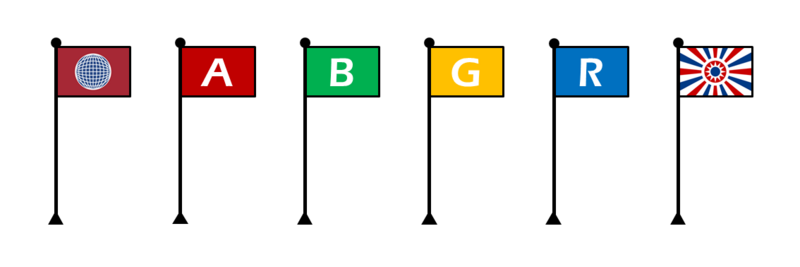
The flags should be listed in alphabetical order in Common terms, with the Sekidean flag (be it the Inner Sekidean Union Banner or the Sekidean Union flag). Zhoushi flag, with the name beginning with "Z", is almost exclusively last, but it is rather a result of the name than a rule
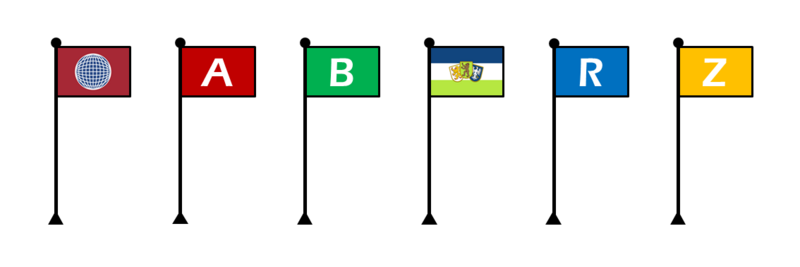
Same rule applies to the Mustelarian flag. This variant, however, is not used so often as Zhousheng and Monte Blanco act as independent entities within the Sekidean Union
Exceptions to the Internal protocol
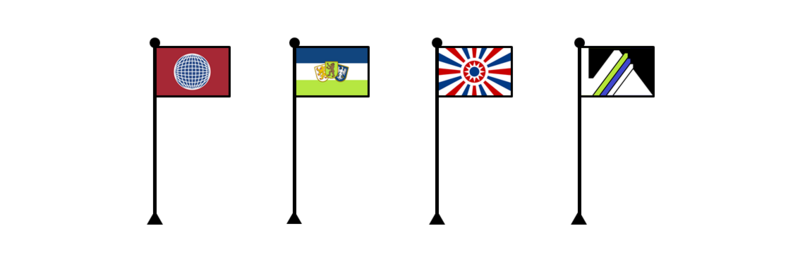
If the Sekidean banner is included, the triad is broken. Mustelarian flag should be then on the centre-left position and Zhoushi flag should be right of it, as based upon the Internal protocol
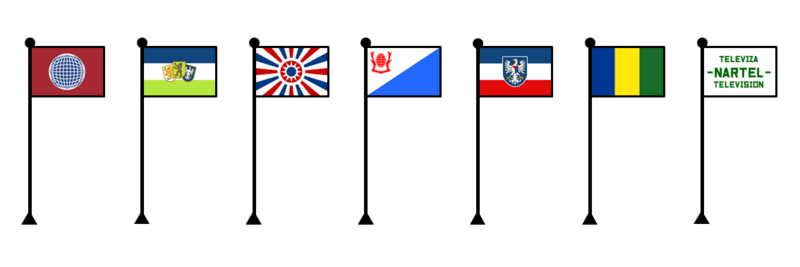
The listing of flags should follow the hierarchy, if the Sekidean flag is included, being listed from the greatest to the lowest from left to right
Example: Flag of the Sekidean Union, flag of Mustelaria, flag of Zhousheng, flag of the Mosterec Region, flag of Bogmia, flag of Helinov & flag of NARTEL
Protocol for autonomies
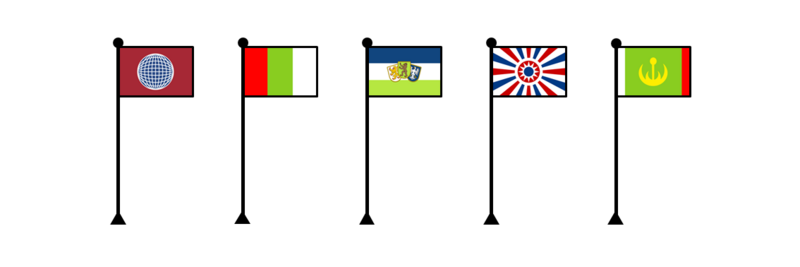
Autonomies have the right to fly foreign flags as their official symbols, but have to follow the following order[3] (left to right): SU flag, autonomy flag, Mustelarian flag, Zhoushi flag and foreign flag
Example: Flag of the Sekidean Union, flag of the Zaprei Autonomy, flag of Mustelaria, flag of Zhousheng & flag of Prei Meas
Dehonestation of the flag
Dehonestation of the flag is a crime punishable by a fee up to 200ᕋ (about ₳250), or up to 5 days of community service. It can be given to people knowingly doing one of the following things, which are considered to humiliate the flag:
- Editing the flag by adding and/or removing a symbol from it (including writing on it)
- Vandalizing the flag (cutting, trimming, bleaching) or throwing the flag into the garbage (only acceptable way to destroy the flag is to burn it in private until it is an ash)
- Burning the flag or destroying it in any way in public
- Using the flag if it is dirty and/or keeping the flag dirty if there is a opportunity to clean it
- Lowering the flag into a grave/crematory furnace with a person who got a state funeral
- Letting the flag touch a ground when lowering it from the flag pole
- Tying the flag into a rosette
- Covering the flag with a logo/symbol (including the Coat of arms)
- Breaking the flag protocol stated above
Zhoushi Presidential standard
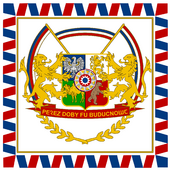 | |
| Use | |
|---|---|
| Proportion | 1:1 |
| Adopted | May 12th, 1912[4] September 6th, 1943 |
| Design | A argent square banner, surrounded by Zhoushi national colors, with a coat of arms on it, carrying two poles with tricolors, Zhengian (azure-gules-argent), Zhoushi (azure-argent-gules) and Bogmian (gules-argent-azure) and two laurel branches under it. |
| Designed by | Filip Noƿotƞin |
 Variant flag of Zhoushi presidential standard | |
| Use | |
| Proportion | 1:1 |
| Adopted | October 1945 |
| Design | A Zhoushi flag with edited side ratio |
| Designed by | Filip Noƿotƞin |
A president of Zhousheng, has his/her own strandard, symbolizing the leadership position of the person.[5] The standard was originally designed as a standard to the Chairman of the Union Assembly, a organ originally supervizing the Zhoushi Union, but after the federalization of 1943, first president was by agreement the Chairman, until the elections could be held. The banner is still using the Bogmian and Zhengian symbols, although the two republic no longer exist even within the federation after the New Year's Integration Bill, being replaced by federal lands, which were later replaced by regions (2019).
The banner is always raised on the building, in which the president is located (except visits). This tradition has been questioned as it may be a security threat to the president in case of a crisis, as foreign assassins would have a confirmation of the location, so multiple standards were created besides the original one, all being raised over the Horady Residence (permanent residence of the president), Zapadny Palace (workplace of the president) and Miklin Residence (alternative residence of the president).
The presidential standard, by law, can not leave Zhoushi territory, so for state visits, a special Zhoushi flag with edited dimensions (1:1) is raised as a "visit standard". This rule has been, however, violated in March 2017, when president Sergej Napiчu visited Monte Blanco and its president Oleg Zühüman to negotiate a restoration of Mustelaria. This symbol had a huge symbolic meaning, as the standard can be raised "Only on the territory Zhoushi person can call home". This symbol was later repeated by Oleg Zühüman on his visit to Zhousheng in May.
The border is, according to description, made out of "...colorful flames in gules & azure colors (...) depicting the flame and water...", the two laurel leaves "...are a symbol of unity and peacefulness of the two [countries]..." and the tricolours "...symbolize unity, as the two tricolors of the two come to make a single one in the middle...". The central tricolor, which later became the tricolor of Zhousheng, is identical to the Pan-Slavic tricolor. Wether it was an intention or a coincidence in design is probably lost to history, as no source on this topic is currently owned by the Zhoushi Vexillological Association.
Proposed flags
With the creation of the Zhoushi Federation in 1943, many flags were proposed, but ultimately, the Union flag was preserved as a federation flag.
| Proposed flag | Name of the flag | Notes |
|---|---|---|
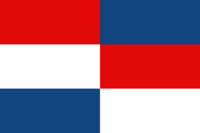
|
Six stripes | Design refused for overall visual chaos |

|
Slavic sun | Design refused for slavic-only symbolism |
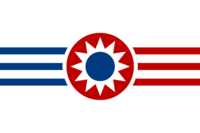
|
Three lines | Design refused for excessive Zhengian symbolism |
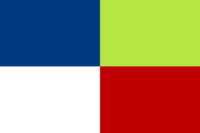
|
Four principles | Design refused for misleading symbolism (Monte Blanco included) |
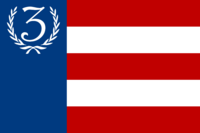
|
Glorious "Ʒ" | Design refused, because foreigners might confuse a letter Ʒ and number 3 |
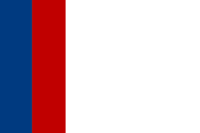
|
The land for everybody | Design refused, because from far, the flag looked like surrender banner |
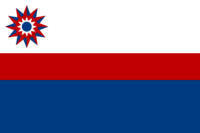
|
The central rosette | Design refused, because of the similarity to Velharian flag |
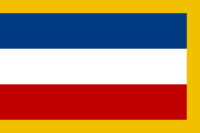
|
Slavic banner | Design refused because of the border thickness |
Subdivision flags
Flag of the Grad Autonomy
Flag of the Prei Mean Lease Ports Zone[6]
Flag of the Storvan Autonomy
Flag of the Zaprei Autonomy
Bogmian region
Flag of the Bogmian region is made out of two equal horizontal bands of blue (top) and white (bottom) with a red isosceles triangle based on the hoist side.
Flag of the region is inspired by the flag of Bogmia, which was a tricolor of blue-white-red and coat of arms of Zhousheng City, which has the Zhoushi 12-pointed star and a red chevron over it.
Central region
Flag of the Central region is made out of four equal horizontal bands of white (top), gold (centre-top), green (centre-bottom) and red (bottom).
Flag of the region is inspired by a quartered field of the coat of arms of Gasnowice, a capital city of the region.
Grad autonomy
Flag of the Grad Autonomy is made out of horizontal bands of white, black and red, where the black band is the ⅕ of the height of the flag.
Flag of the autonomy is inspired by the flag of Gadorien, as Gradi and Gadori populace are both Germanic and closely related.
Kandan region
Flag of the Kandan region is made out of quadrisection of blue (top left), white (top right), green (bottom left) and red (bottom right) with a zhoushi state seal over it.
Flag of the region is inspired by the Zhoushi coat of arms, using the colors of the quartered field of the coat of arms and using the state seal in the middle.
Lonking region
Flag of the Central region is made out of four vertical bands of blue (hoist), red (hoist-centre), white (fly-centre) and blue (fly), where the blue bands are ⅓ of the width of the red and white bands.
Flag of the region is inspired by the Slovanic symbology, using an older Slovanic white-red bicolor and adding a blue stripe to it.
Minimalstrit region
Flag of the Minimalstrit region is made out of plain blue field with five stars in a semi-circle.
Flag of the region is inspired by the symbolic five gates of the city of Minimalstrit, which, according to legend, were never occupied and which, in Zhengian symbology, have five stars directly above them.
Mosterec region
Flag of the Mosterec region is divided diagonally from the lower hoist-side corner to the upper fly-side corner; the upper triangle is white and the lower triangle is blue. A red seal of the city of Mosterec is included in canton.
Flag of the region is inspired by the coast, being the only region of Zhousheng proper having an access to the sea. The seal is made out of a turtle shell, symbolizing a sealife and riches of the region.
Orlobirg region
Flag of the Orlobirg region is made out of 10 equal horizontal bands, interchangebly maroon and white, with a golden vertical band on the hoist, reaching ¼ of the width of the flag.
Flag of the region is a symbol of the trans-mountainous trade, where the maroon symbolizes trade routes and white symbolizes the snow on the top of mountains. The symbology of the golden band is, unfortunately, lost to history.[7]
Prei Mean Lease Ports Zone
Flag is made out of Mustelarian flag in canton with Prei Mean crest as a symbol and a name of the zone in Prei Mean.
Storvan autonomy
Flag of the Storvan Autonomy is a taken national symbol of the Aschari people, which form a majority on the island and are a plurality in Prei Meas and Agarntrop
Ukadsk region
Flag of the Ukadsk region is made out of two equal horizontal stripes, white (top) and red (bottom) with the hoist half of the flag being a quadrisection of gold (1st and 4th field) and blue (2nd and 3rd field) fields.
Flag of the region is most likely inspired by old Zhengian symbols of blue-gold quadrisection. The bicolor is theoretized to be a war banner of the Bogmian Empire.
Zaprei autonomy
Flag of the Zaprei Autonomy is made out of three equal vertical bands, red (hoist), green (centre) and white (fly).
The flag is made out of Prei Mean colors, representing Zaprei and Phná populace in the region. The flag is easily confused with the Civil ensign of Prei Meas rotated 180°.
Historical designs
Flags of the countries existing in present-day Zhousheng changed over centuries, but some of those designs are still widely recognizable by Zhoushi populace.
Former Bogmian national flag
Flag used by the State of Bogmia and Kingdom of Bogmia
Former Zhengian national flag
Flag used by the State of Zhengia
Flag of the Council State
Former Haldenian nationalist flag
Bogmian flag
Still recognized regional flag of Bogmia is by definition "A horizontal tricolour of blue, white and red (Pan-Slavic colors) with a rising Bogmian Eagle". It is often used along Zhoushi national flag by local populace in Central Zhousheng (fomer political centre of Bogmia). Bogmian flag is still raised with regional and state flags by Bogmian and Central Regions on local representative councils. Bogmian flag is still symbolically raised in front of the Zhoushi Parliament, symbolizing the origin of the federation and reminding people going around about their origins.
Zhengian flag
Still recognized regional flag of Zhengia is by definition "A horizontal polycolour, where the upper and lower thirds are blue and the central third is itnerchangebly red and white, with a rampant golden Zhengian Lion". It often used along Zhoushi national flag by local populace in Southern Zhousheng (former Zhengia). Zhengian flag is still raised with regional and state flag by Ukadsk Region on local representative councils. Zhengian flag is still symbolically raised in front of the Zhoushi Parliament, symbolizing the origin of the federation and reminding people going around about their origins.
Council banner
The flag of the Council State is no longer recognized by the Government, but it is seen as a flag of warmongers who's oppression caused unwanted deaths of millions of people during the War of the Council. However, the far left authoritarians still use the Council banner as their symbol. The so called "Council Banner" had no standard design: many variations were used on the frontline and on the occupied territories (including plain red flag, red flag with a red hammer and sickle in a golden star placed in canton, red flag with a golden strip on a hoist etc.).
Some of the forgotten flags were mixed together in the 2020 NARTEL TV Series Maꞇчina.
Haldenian flag
Duchy of Haldenia was a semi-autonomous duchy under the Kingdom of Bogmia, which was seperated by the mountains from the rest of the Empire of Three Kings. Haldenian seperatists repetetively tried creating Haldenia as a equal kingdom to the others, creating the Empire of Four Kings. However, the lack of population and underdevelopment of the region left those proposals in shambles, as they were ignored by the Emperor. The flag is not officially recognized as a historical flag by the Government, however, some institutions especially in the Central Region fly the flags besides the regional, state and Bogmian flag.
- ↑ The green stripe is a remnant of the Empire of Three Kings, which was never removed and was later reinforced with the reunification of Mustelaria
- ↑ The flags are switched if the meeting happens in Monte Blanco. In that case, Zhousheng gets the closing position as a symbol of Mustelaria
- ↑ SU flag can be excluded, either Mustelarian or Zhoushi flag can be excluded as long as SU flag is excluded and one of them stays
- ↑ The flag was used during the times of the Zhoushi Union to represent a Chariman of the Union Assembly. This role was later temporairly transformed into the role of a president.
- ↑ Zhousheng is a parliamentary republic, so president is rather a representative role and a figurehead than a actively important position
- ↑ Design of the flag of the Prei Mean Lease Ports Zone changed with the creation of Mustelaria in 2017. Originally, the flag had Zhengian flag and alter Zhoushi flag
- ↑ Some theories suggest its reference to the anti-communist movement during the War of the Council or some historical color of the ducial leadership of Haldenia
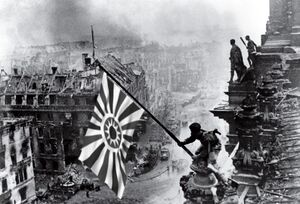

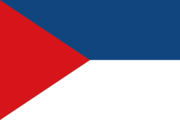
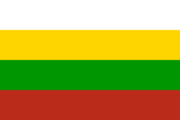
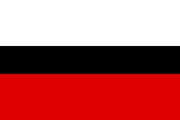
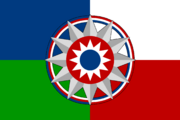
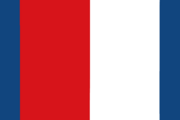

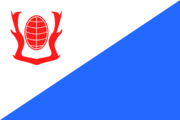
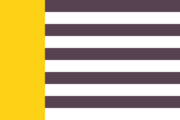
![Flag of the Prei Mean Lease Ports Zone[6]](/mediawiki/images/thumb/8/85/MSPortZonePreiMeas.png/180px-MSPortZonePreiMeas.png)
